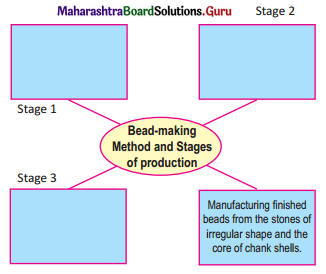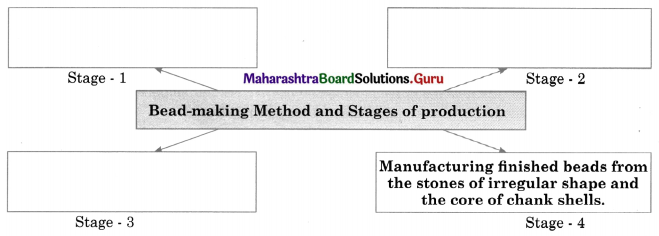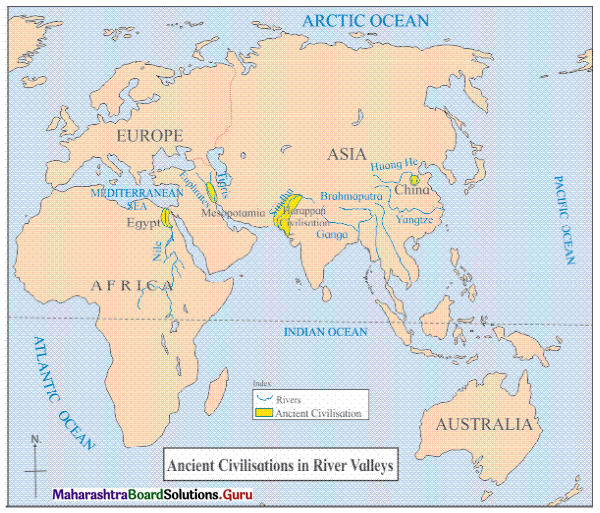Balbharti Maharashtra State Board Class 11 History Solutions Chapter 1 First Farmers Textbook Exercise Questions and Answers.
Maharashtra State Board Class 11 History Solutions Chapter 1 First Farmers
1A. Choose the correct alternative and write the complete sentences.
Question 1.
“Yellow River” is the English translation of the Chinese name ____________
(a) Kemet
(b) Mother
(c) Sorrow
(d) Huang He
Answer:
(d) Huang He
Question 2.
The Australian archaeologist ____________ coined the term ‘Neolithic Revolution’.
(a) Gorden Willey
(b) Gordon Childe
(c) Herodotus
(d) Collingwood
Answer:
(b) Gordon Childe
![]()
Question 3.
The neolithic people at Gilgal had systematically planted ____________ trees.
(a) guava
(b) sapodilla
(c) fig
(d) Indian blackberry
Answer:
(c) fig
Question 4.
____________ in the Shirur taluka of Pune district is an important site of the village of Chalcolithic farmers in Maharashtra.
(a) Saradwadi
(b) Ranjangaon
(c) Pabal
(d) Inamgaon
Answer:
(d) Inamgaon
1B. Find the incorrect pair from set ‘B’ and write the correct ones.
Question 1.
| Set ‘A’ | Set ‘B’ |
| (1) The valley of Tigris and Euphrates | Mesopotamia |
| (2) The valley of Nile | Iran |
| (3) The valley of Huang He | China |
| (4) The valley of Sindhu (Indus) and Saraswati | Indian Subcontinent |
Answer:
(2) The valley of Nile – Egypt
2. Complete the concept maps.
Question 1.

Answer:

3. Explain the following statements with reasons.
Question 1.
The camps of Mesolithic people developed into the first settled villages of neolithic people in Mesopotamia.
Answer:
- Mesopotamia is between the two rivers, Tigris and Euphrates.
- The Mesolithic people began to settle in the region (Mesopotamia) for a longer time, due to the availability of ample water.
- As both the rivers flooded annually, fertile soil was deposited on their banks.
- Ample water and fertile soil resulted in camps of Mesolithic people, who developed into the first settled neolithic villages, which grew wheat and barley.
![]()
Question 2.
‘’Huang He’ river is considered to be the mother of the Chinese culture.
Answer:
- The yellow silt brought by the ‘’Huang He’ river, earns her the name of “Yellow River” in English.
- The other names ‘River’ and ‘Mother’, indicate her extraordinary place in the Chinese culture.
- The name ‘River’ indicates her importance as a river.
- The Chinese culture evolved here, with wheat, foxtail millet, and rice being grown by neolithic farmers in the villages.
Question 3.
In the latter half of the neolithic age, Pottery-making had become an art that required special skills.
Answer:
- The neolithic pottery, in the beginning, was in monochrome, i.e., single colour with a burnished surface. Pots were polished by rubbing with a wooden or stone tool.
- Some pots had carved designs, using techniques of stamping and applique work.
- Gradually Neolithic people began to decorate their pots with painted designs.
- Thus, in the latter half of the Neolithic age, pottery making had become an art that required special skills.
4. State your opinion.
Question 1.
There were radical changes in the way of human life during the neolithic age.
Answer:
- In the neolithic age, people lived settled lives with permanently occupied dwellings.
- The common storage places of food grains indicated that transactions related to food production were centrally controlled.
- Hierarchical social and family structure and concept of inheritance have their roots in Neolithic times.
- Pottery making along with polished stone tools is an essential characteristic of neolithic culture.
- Beads of various types of siliceous stones and chank shells were made, indicating craft specialization and various classes of skilled artisans.
Question 2.
The Neolithic people invented the wheel and the technology they had developed so far, underwent a revolution.
Answer:
- Neolithic people produced wheel-made pottery.
- Wheel technology made it possible to produce pottery on a large scale.
- The invention of the wheel made it possible to obtain raw material from distant places in lesser time.
- It became easier to send the finished goods to distant markets, where it was in more demand.
- It helped to develop trade and commerce and transport on a greater scale.
![]()
5. Observe the map on page 2 of your textbook and answer the following questions based on it.

Question 1.
What is the name of the sea on the African continent?
Answer:
The name of the sea on the African continent is the Mediterranean Sea.
Question 2.
In which continent did Harappan civilization originate?
Answer:
The Harappan civilization originated in the Continent of Asia.
Question 3.
What is the name of the ocean in the south of India?
Answer:
The Indian Ocean is the name of the ocean in the south of India.
6. Write short notes.
Question 1.
Neolithic ‘Jericho’
Answer:
- The Palestinian city of Jericho, on the banks of the River Jordan, is the first neolithic permanent settle’ in 9000 B.C.E.
- It started getting organized into a well-knit society by about 8000 B.C.E.
- The village had a protective wall around it, with a watchtower, giving evidence of an organized society.
- It is proved that cultivation began in Jericho, as discovered at Gilgal a site near Jericho.
- Laboratory analysis has proved that neolithic people had systematically planted fig cuttings,
- This stands to be the first attempt at planned cultivation.
![]()
Question 2.
‘Holocene’ epoch
Answer:
- The last glacial period in the history of our planet came to an end about 12000-11000 years ago.
- This was the beginning of a new epoch, known as ‘Holocene’.
- With the beginning of the Holocene, glaciers began to melt, increasing the volume of water in rivers and oceans.
- As a result, the availability of animals and vegetation for food increased.
- The period witnessed the extinction of gigantic mammoth.
- A variety of fishes, small animals like goats, sheep, deer were available for food.
7. Answer the following questions in detail.
Question 1.
Write in detail about the ‘first farmers’ and the beginning of agriculture in India.
Answer:
- Archaeological sites of Neolithic villages, which have been discovered prove that there were well-settled villages in the Indian subcontinent, as early, as 8000 B.C.E.
- Historian scholars generally agree that the Harappan cities evolved from these early villages.
- Barley was the main crop grown by the farmers in these villages, where wheat was grown on a smaller scale.
- The farmers in these villages were the ‘first farmers’ of the Indian Sub-continent. They lived in mud houses and domesticated cattle and goat-sheep.
- The transition from hunter-gatherer’s life to the beginning of cultivation spans through 10000¬8700 B.C.E.
- The beginning of cultivation is also the beginning of the Neolithic age. The period also marked the domestication of animals along with cultivation.
- While wheat and flaxseeds were grown, barley was the main crop in this period.
- Modified composite tools like fishing harpoons, spears, and arrows were made. Blades known as microliths and tools like sickle and scythe were used for harvesting cereals and fruits.
Question 2.
What knowledge was essential for the Neolithic people to make pottery?
Answer:
- The neolithic pottery, in the beginning, was in monochrome (single colour) with a burnished i.e., polished by running with a wooden or stone tool, surface. Some pots had carved designs.
- The techniques of stamping and applique work i.e., pasting wet clay ribbons and making patterns on them were also used.
- Painted designs on pots in the latter half of the neolithic age, made pottery art that required special skills.
- To master the art of pottery-making one needs to possess knowledge of the following things:
- To know the source of clay of excellent quality.
- To manage to obtain clay.
- To knead and prepare the clay for pottery production.
- To be able to turn the pot to the desired shape.
- To have artistic skills for decorating the pottery.
- To know the technique of making pottery at proper temperatures, approximately 850° – 900° Celsius.
- Pottery helps us to know the cultural history, the material richness of the place, where it was found.
- With the help of pottery, we can also know about the contacts of the residents of the place with other cultures.
![]()
Question 3.
Write about the trade and transport in the Neolithic age.
Answer:
- In the latter half of the Neolithic age, people had started using beasts of burden for transporting goods.
- Tools like axes, scrapers, and chisels enabled neolithic people to cut trees and work on wood.
- Probably the round-shaped pieces of wooden logs were used as wheels, as they could easily gain momentum.
- The neolithic people invented the wheel and the technology they had developed so far underwent a revolution.
- The Neolithic people began to produce wheel-made pottery. The wheel technology made it possible to obtain the raw material from distant places in much lesser time.
- It became easier to send the finished goods to distant markets where it was more in demand.
- It helped to develop trade and transport on a greater scale.
Question 4.
Write about the beginning of urbanization in the Neolithic age.
Answer:
- After settling down at one place for a long time, a feeling of ownership arose among neolithic people.
- This feeling was focused on their individual dwellings and the piece of land cultivated by them.
- With social organization and administration, the villages expanded.
- Along with it, awareness of collective landholdings and the village boundaries became prominent.
- It was thus felt that the village community had a natural right over the immediate territory around the village periphery.
- This kind of awareness of natural rights over a particular region is known as ‘territoriality’.
- Rules and norms were created to manage the collective resources, water sources, crafts dependent on it, trade and community life, etc. Consequently, rituals and their details gained importance.
- The need of managing and keeping records of trade, rituals, writing, systems, and administrative machinery developed.
- It gave rise to administrative centers. Such administrative centers attract a large population that includes officials, people from various occupations.
- As a result, the periphery of the original settlement kept expanding and cities came into being.
- Thus, began the process of urbanization in the Neolithic age.
Activity (Textbook Page No. 9)
Write in detail about any of the ancient civilizations.
Answer:
Among the ten oldest civilizations in the world, Mesopotamian, Indus Valley, Egyptian and Chinese are well known.
1. The Mesopotamian Civilization:
Mesopotamia is the Greek name of the region between two rivers, Tigris and Euphrates. Meso means the ’middle one’ and Potamos means ’river’. The region between the two rivers is ’Mesopotamia’.
- Name of the Civilization: Mesopotamian civilization
- Period: 3500BC-500BC
- Original Location: Northeast by the Zagros mountains, Southeast by the Arabian Plateau
- Current Location: Iraq, Syria, and Turkey
- Meaning: Land between rivers (ancient Greek)
- Major Highlights:
- The first civilization in the world.
- People developed the idea of agriculture and started domesticating animals for both food and farming.
![]()
2. The Indus Valley Civilization:
- Name of the Civilization: Indus Valley civilization
- Period: 3300 BC-1900 BC
- Original Location: Around the basin of the Indus river
- Current Location: Northeast Afghanistan to Pakistan and northwest India
- Major Highlights:
- One of the oldest civilizations in the world.
- One of the three earliest civilizations along with Ancient Mesopotamia and Egypt.
- Most widespread covering an area of 1.25million kilometers. Also known as Harappan and Mohenjo-Daro civilization named after the excavation sites where the remains were originally found.
- A sophisticated and technologically advanced urban culture. This culture was rich in arts and crafts.
3. The Ancient Egyptian Civilization:
- Name of the Civilization: Egyptian civilization
- Period: 3150 BC-30 BC
- Original Location: Banks of the Nile
- Current Location: Egypt
- Major Highlights:
- Construction of Pyramids
- One of the oldest and culturally rich civilizations and a majestic civilization on the banks of the River Nile is known for its Pharaohs, Pyramids, and the Sphinx.
![]()
4. The Chinese Civilization:
- Name of the Civilization: The Chinese civilization
- Period:1600 BC -1046 BC
- Original Location: Yellow River and Yangtze region
- Current Location: Country of China
- Major Highlights:
- Agriculture in the Neolithic villages of China began around 7000 B.C.E.
- Wheat, foxtail millet, and rice were grown by farmers in these villages.
- The invention of paper and silk.